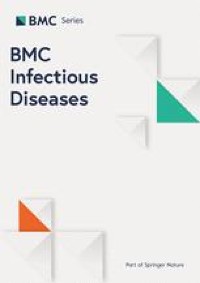Infection
Analysing the implementation of infection prevention and control measures in health care facilities during the COVID-19 pandemic in the African Region
This study assessed IPC measures at facility level to mitigate the spread of COVID-19 nosocomial infection in health care settings during the COVID-19 pandemic [10]. Following the baseline HCF assessments, the IPC median score was 60.2%. However, more than 30% of the HCFs presented an average score of lower than 50%. There was an improvement from 64.3% to 71.4% on reassessment of the HCFs that conducted a follow up assessment, highlighting the critical need for monitoring and feedback to improve IPC capacity. In this study, the components on sanitation and hygiene scored the highest, at 56%, while IPC programmes at facility level, presence of an isolation/waiting area, availability and use of PPE and training/education all had scores of less than 30%. Scores of less than 40% were observed in triage, intra-hospital surveillance, sterilization, bio-cleaning and HW risk assessment. While the COVID-19 pandemic was perceived as a stimulus to improve IPC programmes, the implementation of the WHO minimum requirements during the pandemic is noted to be alarmingly low in the African Region. The study highlights and further strengthens evidence on the low IPC capacity at HCF level within the African Region and the need to strengthen IPC programmes through strategic and operational interventions aligned to the WHO minimum requirements [11]. Improving IPC capacity within the African Region will bolster response capacities to public health emergencies, further impact on the quality of patient care, universal health coverage, anti-microbial resistance programmes, and maternal, newborn and child health and other programmes, while simultaneously improving health systems capacity and resilience [12, 13].
Higher scores were noted in facilities exclusively for COVID-19 patients compared to mixed HCFs, followed by HCFs not dedicated to COVID-19 patients. Tertiary facilities also had better scores followed by secondary and then primary HCFs. While most secondary and tertiary facilities are better equipped in IPC capacity, this study identified gaps in primary HCFs and those not dedicated to COVID-19 patients, whose IPC scores, following assessments, were low. The principal goals of primary HCFs are to ensure quality and safe standards of care that are widespread, comprehensive and accessible to all in the community [14]. However, being the initial contact or first point of care for the community, the primary health care setting is easily exposed to frequent outbreaks, posing a risk to HWs, patients, visitors and the community at large. Treatment centres handling infectious disease outbreaks such as HCFs, designated exclusively for COVID-19 patients are categorized as high-risk facilities in the outbreak settings and hence prioritized for the improvement of IPC capacity at the expense of facilities not handling outbreaks. During the COVID-19 pandemic, there was overt community transmission, with most cases being asymptomatic, causing many HWs to be exposed and disproportionately affected by COVID-19, compared to the general public [6, 15]. Infections among HWs were high in primary HCFs and those not designated for COVID-19 patients, due to inadequate accessibility to IPC enablers such as PPEs, poor risk perception and reduced vigilance or high index of suspicion in these settings [6]. The study highlights gaps and the need to address IPC capacity to respond to COVID-19, health care-associated infections, including AMR across the health system, primary health care settings and non-COVID-19 treatment centres.
HCF that had IPC focal points, IPC guidelines and HWs trained in IPC scored higher than those that did not. In addition, there was a strong correlation between IPC capacity and the presence of IPC focal point in HCFs, the availability of IPC guidelines in HCFs and HCFs that have all its HW trained in basic IPC. The multi-modal strategy highlights the added value of efficiently combining multiple modalities for a synergized response in improving IPC capacity [16, 17]. In this study, the components on IPC focal points, guidelines and training each had an incremental effect in IPC scores, while the combination of the three further raised the scores with an exponential improvement in facilities implementing the three components.
Surveillance of healthcare-associated infections particularly for HW infection is a critical part of IPC. When results of HW infections are timeously reported to managers, there is more likelihood that outbreaks will be detected timeously and mitigation measures established to curb further spread of infection. Some of the HCFs (35.71%) were reported to be experiencing HW risk exposure while others were not. This indicates gaps in HW surveillance and implementation strategies for the protection of HWs in Africa. The health care workforce is the cornerstone of the health system, and is critical to the provision of health care and ensuring continuity of essential quality health care services. Without them, no services are rendered or sustainable even when other parts of the health system are improved [13].
The results in this study are similar to the recently published global IPC survey where the overall Infection Prevention Control Assessment Framework (IPCAF) HCF scores were significantly low in African Region compared to other regions, with the lowest scores in IPC training and education, PPE availability and accessibility [13]. Complimentary to this study and global IPC survey [13], the lack of or limited availability of PPE was also noted in two pulse surveys by WHO on continuity of essential health services the during COVID-19 pandemic [18, 19]. Regarding IPC capacity at different levels of HCFs, the 2019 IPC global survey observed that IPCAF scores in tertiary facilities were higher than in primary HCFs [13].
This is the first study assessing the IPC components in healthcare settings during the COVID-19 pandemic, underscoring the need for other complimentary studies for generalizability and comprehensiveness in reviewing IPC capacity in the African Region. Additionally, the study only looks into the IPC capacity at the facility level. It is paramount to further review capacities at the national level.

